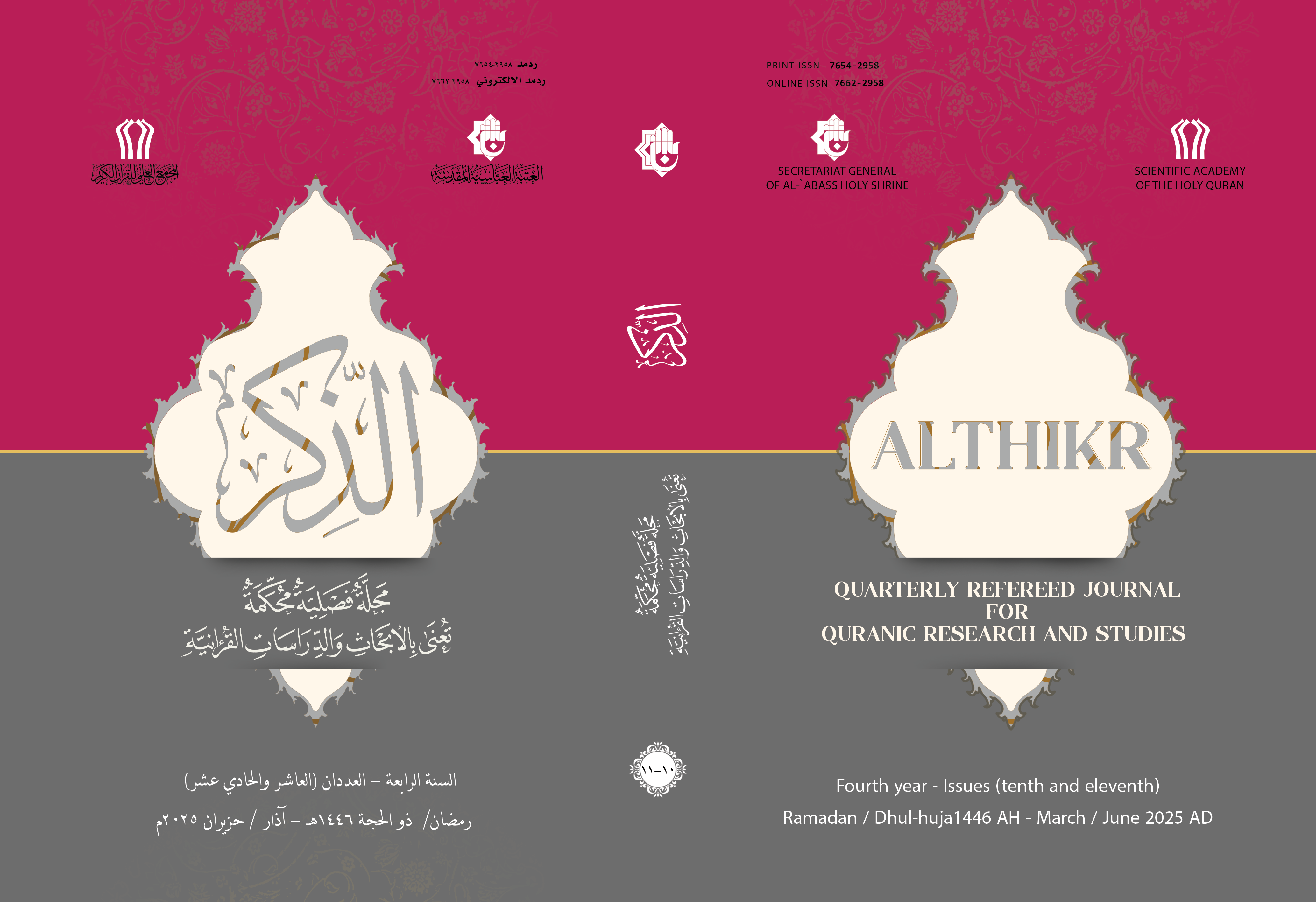Abstract
This study، The Critical Interpretative Methodology of Sheikh Al-Tusi in Tafsir al-Tibyan، explores Sheikh Al-Tusi’s critical approach to Qur’anic exegesis، which follows two primary directions: the critique of interpretative opinions and the critique of interpretative narrations.
In the first aspect، Sheikh Al-Tusi critically evaluates the views of exegetes he cites، drawing from a wide range of scholars in the fields of exegesis and linguistics. After presenting their opinions، he engages in comparative analysis، often using terms such as more appropriate (al-āliqu) or stronger (al-aqwa) to express his preference. In some cases، he outright rejects certain interpretations، describing them as unacceptable or invalid. His critique is not influenced by personal bias but is grounded in strong evidential foundations، including the apparent meaning of the Qur’anic text، the context of revelation (asbab al-nuzul)، linguistic considerations، and other scholarly principles.
Regarding his critique of interpretative narrations، Sheikh Al-Tusi employs a systematic methodology that encompasses three key dimensions: the evaluation of solitary reports (khabar al-wahid)، the critical analysis of the textual content of hadith (matn criticism)، and the examination of the hadith chain of transmission (isnad criticism). His critique of hadith texts is primarily rational، while his evaluation of hadith chains is minimal، as he often omits the chains of transmission in his exegesis.
The study concludes with several findings and recommendations، the most significant of which is the proposal to introduce Critical Exegetical Studies as a specialized course for graduate students.
In the first aspect، Sheikh Al-Tusi critically evaluates the views of exegetes he cites، drawing from a wide range of scholars in the fields of exegesis and linguistics. After presenting their opinions، he engages in comparative analysis، often using terms such as more appropriate (al-āliqu) or stronger (al-aqwa) to express his preference. In some cases، he outright rejects certain interpretations، describing them as unacceptable or invalid. His critique is not influenced by personal bias but is grounded in strong evidential foundations، including the apparent meaning of the Qur’anic text، the context of revelation (asbab al-nuzul)، linguistic considerations، and other scholarly principles.
Regarding his critique of interpretative narrations، Sheikh Al-Tusi employs a systematic methodology that encompasses three key dimensions: the evaluation of solitary reports (khabar al-wahid)، the critical analysis of the textual content of hadith (matn criticism)، and the examination of the hadith chain of transmission (isnad criticism). His critique of hadith texts is primarily rational، while his evaluation of hadith chains is minimal، as he often omits the chains of transmission in his exegesis.
The study concludes with several findings and recommendations، the most significant of which is the proposal to introduce Critical Exegetical Studies as a specialized course for graduate students.
Keywords
Textual Apparency - Critical Methodology - Reason - Language
Abstract
هذا البحث (المنهج النّقديّ التّفسيريّ عند الشّيخ الطّوسيّ في تفسير التّبيان) دراسة للمنهجيّة النّقديّة للشّيخ الطّوسيّ وكان منهجه النّقديّ (رحمه الله) يسير باتّجاهين؛ وهما:
الاتّجاه الأوّل: نقد الأقوال التّفسيريّة
الاتّجاه الثّاني: نقد الرّواية التّفسيريّة
ففي الاتّجاه الأوّل ينقد أقوال المفسّرين الّذي نقل عنهم؛ وقد نقل عن مجموعة كبيرة من المفسّرين والنّحاة؛ فبعد أنْ ينقلَ أقوالهم كما هي يبدأ بالتّرجيح بين الأقوال بقوله الألْيَق أو الأقوى وغيرها من الألفاظ في الحالة الأولى وفي الحالة الثّانية يردّ بعض الأقوال التّفسيريّة ويعدّها لا شيء وكان لا يعتمد على الهوى أو الميل النّفسيّ في نقد الرّوايات، بل يعتمد على أدلّة قويّة؛ أهمّها: ظاهر القرآن الكريم، سبب النّزول ،اللّغة، وغيرها، أمّا في ما يخصّ نقد الرّواية التّفسيريّة فكان منهجه النّقديّ يسير بثلاثة اتّجاهات؛ وهي: خبر الواحد، نقد متن الحديث، نقد سند الحديث، وكان نقده للمتن انتقادًا عقليًّا كما كان ينقد سند الحديث وهو قليل جدًّا؛ لأنّ الشّيخ كان يحذف الأسانيد، وخلُص البحث إلى مجموعة من الاستنتاجات والتّوصيات وأهمّ التّوصيات استحداث مادّة النّقد التّفسيريّ لطلبة الدّراسات العليا .
الاتّجاه الأوّل: نقد الأقوال التّفسيريّة
الاتّجاه الثّاني: نقد الرّواية التّفسيريّة
ففي الاتّجاه الأوّل ينقد أقوال المفسّرين الّذي نقل عنهم؛ وقد نقل عن مجموعة كبيرة من المفسّرين والنّحاة؛ فبعد أنْ ينقلَ أقوالهم كما هي يبدأ بالتّرجيح بين الأقوال بقوله الألْيَق أو الأقوى وغيرها من الألفاظ في الحالة الأولى وفي الحالة الثّانية يردّ بعض الأقوال التّفسيريّة ويعدّها لا شيء وكان لا يعتمد على الهوى أو الميل النّفسيّ في نقد الرّوايات، بل يعتمد على أدلّة قويّة؛ أهمّها: ظاهر القرآن الكريم، سبب النّزول ،اللّغة، وغيرها، أمّا في ما يخصّ نقد الرّواية التّفسيريّة فكان منهجه النّقديّ يسير بثلاثة اتّجاهات؛ وهي: خبر الواحد، نقد متن الحديث، نقد سند الحديث، وكان نقده للمتن انتقادًا عقليًّا كما كان ينقد سند الحديث وهو قليل جدًّا؛ لأنّ الشّيخ كان يحذف الأسانيد، وخلُص البحث إلى مجموعة من الاستنتاجات والتّوصيات وأهمّ التّوصيات استحداث مادّة النّقد التّفسيريّ لطلبة الدّراسات العليا .
Keywords
ظاهر النّصّ- المنهج النّقديّ- العقل- اللّغة
